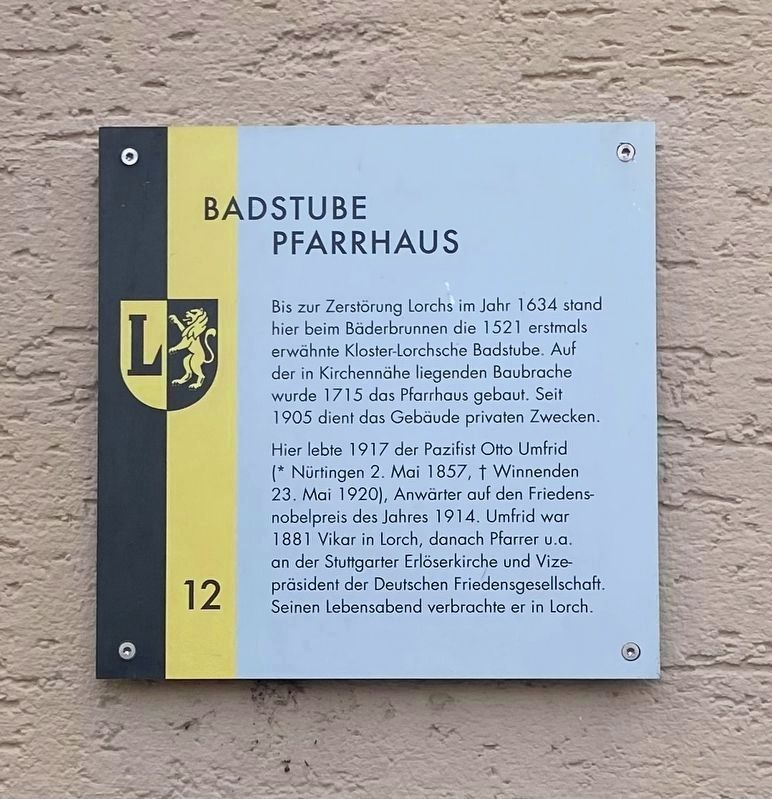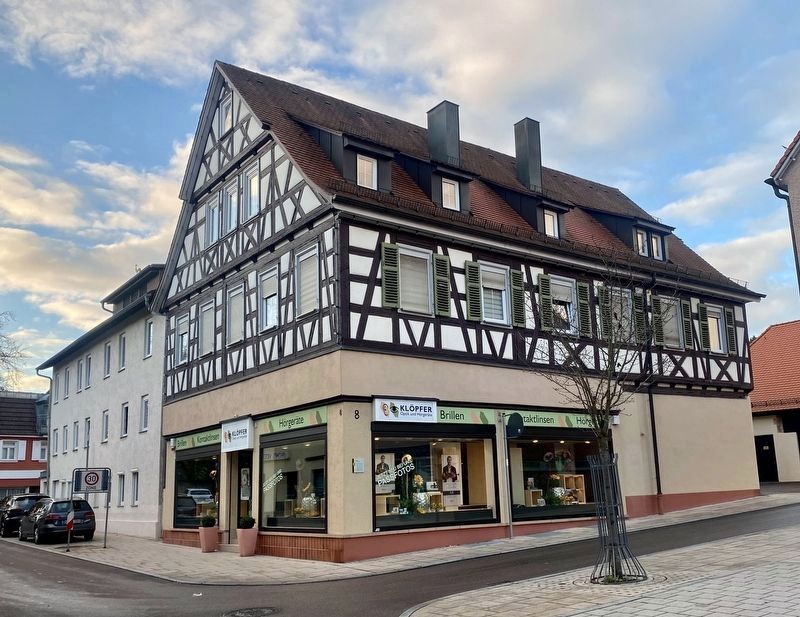Lorch in Ostalbkreis, Baden-Württemberg, Germany — Central Europe
Badstube Pfarrhaus / Bathing Facilities, Rectory
Inscription.
Bis zur Zerstörung Lorchs im Jahr 1634 stand hier beim Bäderbrunnen die 1521 erstmals erwähnte Kloster-Lorchsche Badstube. Auf der in Kirchennähe liegenden Baubrache wurde 1715 das Pfarrhaus gebaut. Seit 1905 dient das Gebäude privaten Zwecken.
Hier lebte 1917 der Pazifist Otto Umfrid (* Nürtingen 2. Mai 1857, † Winnenden 23. Mai 1920), Anwärter auf den Friedensnobelpreis des Jahres 1914. Umfrid war 1881 Vikar in Lorch, danach Pfarrer u.a. an der Stuttgarter Erlöserkirche und Vizepräsident der Deutschen Friedensgesellschaft. Seinen Lebensabend verbrachte er in Lorch.
Until Lorch's destruction in 1634, the Kloster Lorch bathing facility, which was first mentioned in 1521, stood here at the Bäderbrunnen (“Bathing Springs”). The rectory was built in 1715 on the wasteland near the church. Since 1905, the building has been used for private purposes.
In 1917, the pacifist Otto Umfrid (born Nürtingen 2. May 1857, died Winnenden 23. May 1920), candidate for the Nobel Peace Prize of 1914 lived here. Umfrid was a vicar in Lorch in 1881, then pastor at the Stuttgart Church of the Redeemer and vice president of the German Peace Society, among others things. He spent his twilight years in Lorch.
Erected by Stadt Lorch. (Marker Number 12.)
Topics. This historical marker is listed in these topic lists: Churches & Religion • Peace.
Location. 48° 47.899′ N, 9° 41.371′ E. Marker is in Lorch, Baden-Württemberg, in Ostalbkreis. Marker is on Kirchstraße, on the right when traveling west. Touch for map. Marker is at or near this postal address: Kirchstraße 8, Lorch BW 73547, Germany. Touch for directions.
Other nearby markers. At least 8 other markers are within walking distance of this marker. Gefängnis Rathaus / Jail, City Hall (a few steps from this marker); Oberamtei, Oberförstei, Rathaus / Magistrate Office, Forestry Office, City Hall (within shouting distance of this marker); Mörikehaus / Home of Eduard Mörike (within shouting distance of this marker); Goldener Adler (within shouting distance of this marker); Apotheke / Apothecary (within shouting distance of this marker); Grüner Baum / Green Tree Inn (about 90 meters away, measured in a direct line); Wohn- und Handwerker Haus / Residential and Craftworkers House (approx. 0.3 kilometers away); Bahnhof / Railway Station (approx. 0.4 kilometers away). Touch for a list and map of all markers in Lorch.
Also see . . .
Otto Umfrid (Wikipedia, in German).
Overview and goals (in translation): Otto Ludwig Umfrid ( May 2, 1857 in Nürtingen – May 23, 1920 in Winnenden) was a German Protestant theologian and pacifist ... Umfrid turned against armament and war for theological reasons, because Christ had preached peace. He considered it blasphemy to justify war on nationalistic grounds. On the other hand, he aimed for a European confederation of states that would secure peace. The idea could be traced back to the French pacifist Paul Henri Baron d'Estournelles de Constant, who feared that North America and Asia were outstripping Europe economically and politically… Since his student days, Umfrid was also been influenced by the pacifist ideas of Karl Christian Planck, a Swabian philosopher. As early as 1852, Planck called for a world government in connection with an international community of states to ensure world peace.(Submitted on January 28, 2023.)
Umfrid took up these thoughts and developed them further, becoming the core of his pacifist aspirations. He criticized the maintenance of nationalistic enemy images. Only a European confederation of states could guarantee lasting peace in the old world. In his 1913 publication Europa den Europeann he published his idea, but emphasized that the federation of European states could only be the preliminary stage of a "symbiosis of mankind". His major goal was a globally cooperative family of states. Also, Umfrid called for elementary human rights in Europe and tried to transfer them to bilateral, interstate relations. He also opposed discriminatory racial theories, which he saw as a "blatant relapse into barbarism".
Credits. This page was last revised on January 28, 2023. It was originally submitted on January 28, 2023, by Andrew Ruppenstein of Lamorinda, California. This page has been viewed 36 times since then and 6 times this year. Photos: 1, 2. submitted on January 28, 2023, by Andrew Ruppenstein of Lamorinda, California.

